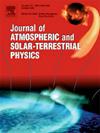Climatological trends and variability of fog characteristics and meteorological parameters over cities along the Indo-Gangetic Plain
IF 1.9
4区 地球科学
Q3 GEOCHEMISTRY & GEOPHYSICS
Journal of Atmospheric and Solar-Terrestrial Physics
Pub Date : 2025-08-27
DOI:10.1016/j.jastp.2025.106616
引用次数: 0
Abstract
The Indo-Gangetic Plains (IGP) in the northern region of India experience widespread and persistent winter dense fog with significant variability and intensity that severely disrupts the transport and impacts human health. The present study investigated the climatological of trends of fog hours, days, duration and intensity, over five city regions; Amritsar (31.42° N, 74.47° E), Delhi (28.56° N, 77.1° E), Lucknow (26.7655° N, 80.8854° E), Patna (25.5941° N, 85.1376° E) and Gaya (24.7914° N, 85.0002° E) using half-hourly surface observations of visibility and meteorological observations during winter months from 1991 to 2024. The non-parametric statistical methods, including the Mann-Kendall test and Theil-Sen's slope estimator, were used to assess trends in fog variations during the winter months of the study period. The classification of fog events into radiation and advection types reveals a dominant contribution of radiation fog, accounting for more than 80 % of total fog events across all five cities. Higher and statistically significant increasing trends in fog hours and days are noticed throughout the cities, even during November and February. Short-duration fog events show predominantly declining trends, especially in Amritsar and Delhi, whereas moderate-duration and long-duration events show increasing trends in Amritsar, Delhi, and Lucknow. A higher percentage of short, moderate, and long duration fog events are noticed in shallow and moderate intensity fog cases compared to dense and very dense fog conditions. The analysis reveals a significant trend in shallow, moderate, dense, and very dense intensity of events is noticed in western IGP cities (Amritsar, Delhi, and Lucknow) compared to eastern IGP cities (Patna and Gaya). Climatological trends of air temperature exhibit increasing (decreasing) trends in air temperature during all fog intensity conditions over western IGP (eastern IGP) cities, whereas relative humidity reveals an overall increasing trend in the winter months.
印度恒河平原沿线城市雾特征和气象参数的气候趋势和变率
印度北部地区的印度-恒河平原(IGP)经历了广泛和持续的冬季浓雾,具有显著的可变性和强度,严重扰乱了运输并影响了人类健康。本研究调查了5个城市地区雾时、日、持续时间和强度的气候变化趋势;阿姆利则(31.42°N, 74.47°E)、德里(28.56°N, 77.1°E)、勒克诺(26.7655°N, 80.8854°E)、帕特纳(25.5941°N, 85.1376°E)和伽耶(24.7914°N, 85.0002°E)等5个城市冬季能见度和气象观测资料的半小时观测结果。采用非参数统计方法,包括Mann-Kendall检验和Theil-Sen斜率估计,评估了研究期间冬季月份雾的变化趋势。雾事件分为辐射和平流类型,辐射雾占主导地位,占所有五个城市总雾事件的80%以上。在整个城市,甚至在11月和2月,雾小时数和天数都有更高的和统计上显著的增加趋势。短时间雾事件呈现出明显的下降趋势,特别是在阿姆利则和德里,而在阿姆利则、德里和勒克瑙,中时间雾事件和长时间雾事件呈现出增加趋势。与浓雾和非常浓雾相比,在浅雾和中等雾的情况下,注意到短、中、长持续时间的雾事件的百分比更高。分析显示,与东部IGP城市(巴特那和伽耶)相比,西部IGP城市(阿姆利则、德里和勒克瑙)注意到浅、中等、密集和非常密集的事件强度的显著趋势。在所有雾强条件下,IGP西部(东部)城市的气温呈上升(下降)趋势,而相对湿度在冬季总体呈上升趋势。
本文章由计算机程序翻译,如有差异,请以英文原文为准。
求助全文
约1分钟内获得全文
求助全文
来源期刊

Journal of Atmospheric and Solar-Terrestrial Physics
地学-地球化学与地球物理
CiteScore
4.10
自引率
5.30%
发文量
95
审稿时长
6 months
期刊介绍:
The Journal of Atmospheric and Solar-Terrestrial Physics (JASTP) is an international journal concerned with the inter-disciplinary science of the Earth''s atmospheric and space environment, especially the highly varied and highly variable physical phenomena that occur in this natural laboratory and the processes that couple them.
The journal covers the physical processes operating in the troposphere, stratosphere, mesosphere, thermosphere, ionosphere, magnetosphere, the Sun, interplanetary medium, and heliosphere. Phenomena occurring in other "spheres", solar influences on climate, and supporting laboratory measurements are also considered. The journal deals especially with the coupling between the different regions.
Solar flares, coronal mass ejections, and other energetic events on the Sun create interesting and important perturbations in the near-Earth space environment. The physics of such "space weather" is central to the Journal of Atmospheric and Solar-Terrestrial Physics and the journal welcomes papers that lead in the direction of a predictive understanding of the coupled system. Regarding the upper atmosphere, the subjects of aeronomy, geomagnetism and geoelectricity, auroral phenomena, radio wave propagation, and plasma instabilities, are examples within the broad field of solar-terrestrial physics which emphasise the energy exchange between the solar wind, the magnetospheric and ionospheric plasmas, and the neutral gas. In the lower atmosphere, topics covered range from mesoscale to global scale dynamics, to atmospheric electricity, lightning and its effects, and to anthropogenic changes.
 求助内容:
求助内容: 应助结果提醒方式:
应助结果提醒方式:


